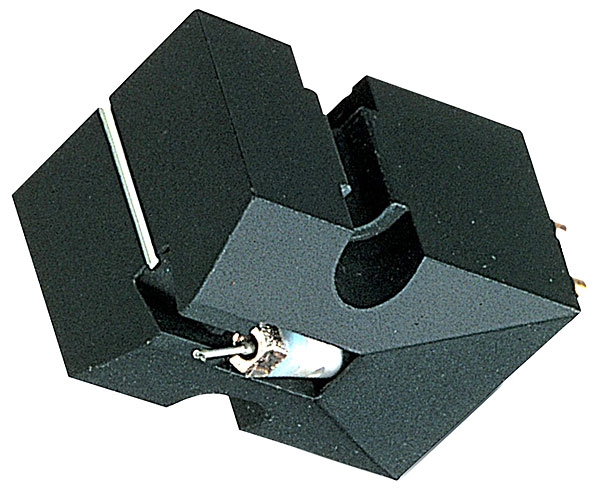Moving magnet cartridges with excellent compliance were all the rage in the vinyl world in the 1970s. The M75ED, which was debuted in 1974, ruled the roost. The manufacturer claimed it could track securely down to 0.75g thanks to its ultra-light design and great compliance. The VMS20E from Ortofon was another famous design that pushed the market toward minimal bulk. In 1978, SME released the Series III tonearm, which furthered the trend toward low mass, high compliance moving magnets. This was the genre’s pinnacle; after that, everything started to head in the opposite direction.
By the end of the decade, the hi-fi world had become enamored with moving coils, which necessitated the use of more massy tonearms to cope with their stiffer suspensions and heavier bodies. A new series of massive ‘battleship’ tonearms, such as the Linn Ittok LVII and Zeta, were launched to best leverage a new wave of Japanese-built high-end designs from the likes of Supex, Dynavector, and Koetsu. As a result, the 1979 release of the Technics EPC-205C MK3 moving magnet cartridge couldn’t have come at a worse moment.
It may not have been fashionable, but for £69 – half the price of a Supex moving coil – it was unquestionably the most advanced moving magnet of its day. It was released during the harvest years of the vinyl LP format, by a brilliant inventive Japanese firm at the top of its game, but it was a complete underachiever in terms of sales. The EPC-205CMK3 was designed with the goal of creating a moving magnet cartridge that was highly fast, clean, and precise. They believed that an ultra-responsive cantilever and a very effective suspension system were the keys to success.
To that purpose, the new moving magnet included a cantilever with an effective moving mass of 0.149mg, which was less than a sixth of the company’s first modern moving magnet, the EPC-200, from 1968, and less than half of its 1973 predecessor, the EPC-205CMK2. It was created using a chemical vapor deposition process and had significantly more flexibility than other materials, according to Technics; it was over twice as compliant as more regularly used aluminium designs. A meticulously developed suspension system – termed the Technics Temperature Defense Damper, no less – was also installed. This was comprised of an unique polymer composition that claimed to keep frequency responsiveness, compliance, and tracking ability stable across a wide temperature range.
Technics claimed a ruler-flat frequency response from 20Hz to 15kHz (-0.5dB) and an overall response of 5Hz to 80kHz for this cartridge, which was quite impressive for its time. This is partly due to the light yet extremely hard Boron cantilever stated earlier, although the high-quality 0.20.7mm elliptical stylus also had a role. Unlike its movie coil competitors, this one was simple to change — the part number was EPS-205ED3. Technics’ electromagnetic generator system features a precision-ground, mirror-finished HPF core, which is believed to produce a flatter frequency response, as well as a high-energy, disc-shaped Samarium cobalt magnet with a single-point suspension mechanism. The latter provided more sensitivity for less weight, and the bridge yoke structure allowed for smaller cantilever dimensions and hence less mass.
Prospective buyers of this cartridge have the option of choosing between regular half-inch mounting bodies and the integrated headshell EPC-205CMK3 model shown below. For the Technics SL-7 and SL-10 tiny parallel tracking turntables, there was also a low-mass EPC-205IIIL variant. This model had a light diecast aluminium headshell with visco-elastic dampening to reduce resonance. Both overhang and angle are adjustable to accommodate the various tonearm lengths it will encounter; in comparison to having to align a typical cartridge in a normal slotted headshell, the elegant screw adjustment system makes setup a breeze. The product’s profile also helps here: it’s not too thick and doesn’t have any unusual protrusions, and the finger lift is satisfyingly large and tactile for those of us who prefer to cue vinyl by hand. The combined cartridge and headshell’s overall compliance is rated as a decent 1210-6cm/dyne at 100Hz, and its reported output voltage of 2.0mV is respectable for the time period, albeit a touch low now. The EPC-205CMK3 should be tracked at a force of between 1g and 1.5g, with the recommended force being in the middle.
Sweet tone and stereo soundstaging are two of this unique Technics moving magnet’s major acoustic characteristics. When you combine these elements, you produce a cartridge that plays music in a beautiful manner. It’s also really quick, which results in a sound that’s both intimate and expressive, with a lot of dynamics and emotional power. The Technics’ refinement, on the other hand, means you’re never hearing the sound of a cartridge straining to keep its needle in the groove — it’s always calm and quiet. Although the EPC-205CMK3 lacks the crystalline clarity and low-level detail resolution of its more expensive moving coil competitors, it lacks none of their allure. Indeed, it’s a highly accomplished moving magnet cartridge – not just by today’s standards, but also by those of its era. So it’s a pity that this wonderful moving magnet – possibly one of the best – was never widely recognized.
Because so many were sold around the world, it’s still possible to find a good example these days – but expect to have it rebuilt and/or given a new stylus assembly for optimal performance. Prices for a nice, boxed specimen start at around £200; buy carefully and/or have it rebuilt, and you’ll see why those who own them tend to keep them. Even now, it’s a fascinating and worthwhile cartridge. It has a sound that is more frequently associated with high-end moving coils due to its combination of refinement, detail, and speed.







